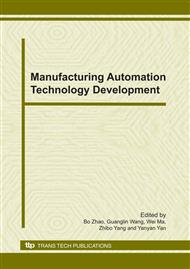p.181
p.186
p.190
p.194
p.200
p.206
p.211
p.216
p.220
Quantitative Analysis of the Extrusion Process of AZ31 Magnesium Alloy Based on Rough Set Theory and 3DFEM Simulation
Abstract:
The effect of extrusion process on the quality of AZ31 magnesium extrudate was performed, by data mining from 3DFEM simulation and Rough Set Theory(RST). The weight of the effect of processing parameters and die structures can be obtained to predict the product quality, to optimize the extrusion processing and the die design. The results show that the effect of the billet temperature on the product quality is dominate, and its average weight is 0.25. The second important parameter is the ram speed and its average weight is 0.21. The third is the extrusion ratio. Its average weight is 0.18. In addition, it was also found that the effect of the die characteristic parameters on the extrudate is insignificant. Finally, the rationality of the weight of effect was verified through experiments.
Info:
Periodical:
Pages:
200-205
Citation:
Online since:
December 2010
Authors:
Price:
Сopyright:
© 2011 Trans Tech Publications Ltd. All Rights Reserved
Share:
Citation:


